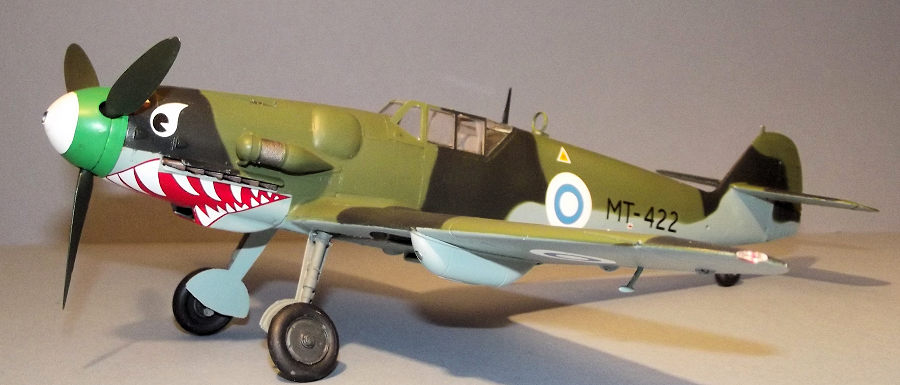
| KIT #: | 04665 |
| PRICE: | £17-00 |
| DECALS: | Two options |
| REVIEWER: | Frank Reynolds |
| NOTES: | Microscale decals #32-034 $17-00. HGW 132502 Seat Belts, £8-30. Eduard EDJX043 Canopy mask £4-40 |

| HISTORY |
The Finnish Air Force received its first Bf 109s in
1943. A total of 162 aircraft of this type were to be purchased and the first
was delivered on 13 March 1943. In total, 159 aircraft were taken into service,
as three were lost en-route. 109 examples were G-6s. The Bf 109 remains the most
numerous aircraft type to have served in the
 Finnish Air Force. The aircraft was
nicknamed Mersu in popular parlance (the same nickname as used for Mercedes-Benz
cars) and carried the designation MT and a 3-digit identification number. With
the arrival of the 109s, the Finns could once again fight an opponent on a more
even basis, as they could match the latest Soviet fighters. The last of the
aircraft arrived in Finland on 20 August 1944, just before the armistice with
the Soviet Union.
Finnish Air Force. The aircraft was
nicknamed Mersu in popular parlance (the same nickname as used for Mercedes-Benz
cars) and carried the designation MT and a 3-digit identification number. With
the arrival of the 109s, the Finns could once again fight an opponent on a more
even basis, as they could match the latest Soviet fighters. The last of the
aircraft arrived in Finland on 20 August 1944, just before the armistice with
the Soviet Union.
The Finns scored 667 confirmed victories with the type, losing 34 Bf 109s to enemy fighters or anti-aircraft fire. A further 16 were lost in accidents and eight aircraft were destroyed on the ground. Twenty-three pilots were killed.
102 Bf 109s survived World War 2, and the aircraft remained the main fighter of the Finnish Air Force for almost a decade afterwards. Despite the aircraft's expected lifespan of 100–200 flight hours, it continued in service until spring 1954 when the FAF entered the Jet Age. The last flight was on 13 March 1954 by Major Erkki Heinilä in aircraft MT-507.
| THE KIT |
This was reviewed by me for MM in November 2017 so I shall not repeat the description and build details here apart from pointing out that the underwing cannon pods must be sourced separately, as must a dust filter.
| CONSTRUCTION |
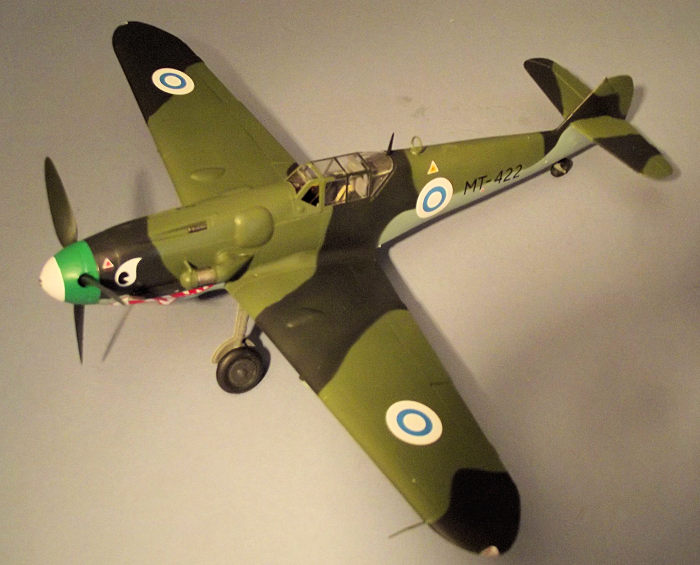 With plenty of 109s in my showcase already carrying
swastikas, a post-World War 2 Finnish Bf109G has been on my wants list for a
long time.
With plenty of 109s in my showcase already carrying
swastikas, a post-World War 2 Finnish Bf109G has been on my wants list for a
long time.
Aircraft MT-422 has attained something of a mythical status due to its spectacular shark mouth nose decoration. It was recorded with this paint scheme in February 1948 when operated by HeLeLv31 “Bat” squadron at Utti, Finland. It is believed that the shark mouth motif was removed within days, since it had not been approved by officialdom. Although fitted with under wing cannon gondolas, the guns had apparently been removed for peacetime operations.
The distinctive finish has proved to be popular with kit manufacturers and it has appeared in both 1/72 and 1/48 from various manufacturers. Locating the subject in 1/32 proved to be more problematic until I chanced upon an internet vendor offering an old Micro Scale decal sheet. $17-00 netted me what I needed, but the tension increased when I examined them upon delivery to find that they were dated from the mid-1980s. The sheet, numbered 32-34, offered three colour schemes for “Foreign Messerchmitts”, the Finnish version that was my prize, a set for a Bulgarian Air Force example and one Swiss. Some of the unwanted decals were sacrificed to check whether they were still valid after 30 years. They certainly took a great deal of soaking, over 20 minutes in very warm water, before they could be persuaded to move but eventually I was satisfied that they could be put to use on this project. I also scanned the sheet so that I could cut out paper patterns and experiment with positioning the decals.
The next challenge came in trying to establish a credible camouflage and markings scheme. Many internet illustrations are artist’s impressions and they offer conflicting opinions. Micro Scale’s sketchy original instructions show both the shark mouth and a large Bat badge on the fuselage side.
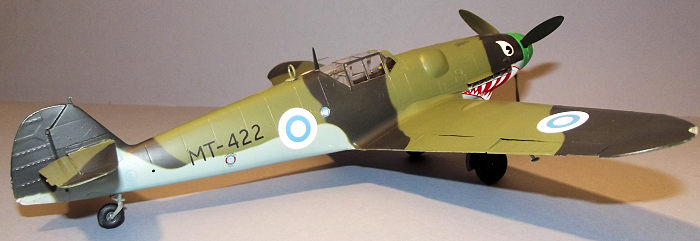 I came upon Eduard’s web site where the instruction
sheet for their 1/48 version are available for download. I obtained a screen
shot of Airfix’s colour three view for their offering of the same subject. The
internet consensus seems to be that MT-422 could feature both shark mouth and a
large bat insignia on the left fuselage side under the cockpit, but not at the
same time.
I came upon Eduard’s web site where the instruction
sheet for their 1/48 version are available for download. I obtained a screen
shot of Airfix’s colour three view for their offering of the same subject. The
internet consensus seems to be that MT-422 could feature both shark mouth and a
large bat insignia on the left fuselage side under the cockpit, but not at the
same time.
The next conundrum came with the camouflage pattern and demarcation lines where again different artists gave different renderings of the same aircraft. Eventually I settled on a format that met my needs. I have to acknowledge considerable assistance from my son, Rich Reynolds, who has a passion for Finnish military history in the 20th Century and a library to match.
| COLORS & MARKINGS |
The exhausts were masked out with small strips of Tamiya tape and the airframe gently washed down with methylated spirits to remove any greasy finger prints before the radiator intakes were plugged with small offcuts of plastic sponge and the cockpit area primed with Dark Grey auto primer applied from a rattle can, to give a dark finish to the canopy interior framing. The whole airframe was then finished in Tamiya Ultra Fine White primer to provide a depth of colour to the under surface and to the lurid green of the top side. The propeller spinner parts received a blast of White at the same time.
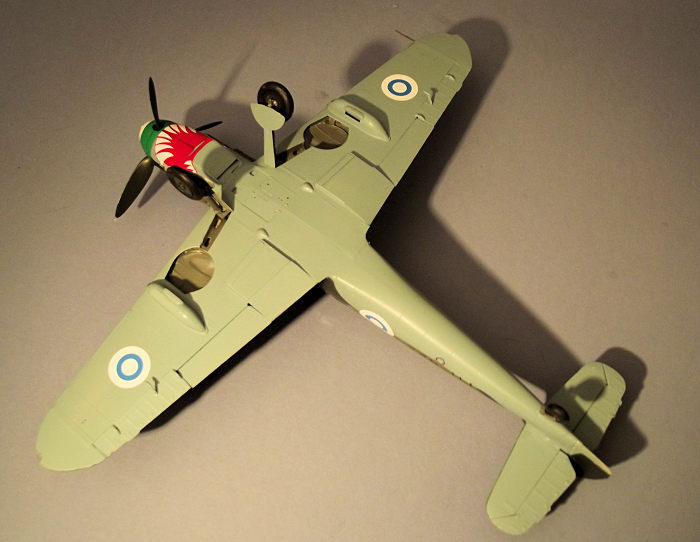 Using my ever-faithful Iwata HP-C airbrush the under
surfaces were finished in Tamiya XF-23 Light Blue and masked off with Tamiya
tape. The upper surfaces were painted in a home brew colour that started off as
Tamiya XF-4 Yellow Green, to which progressive dabs of XF-26 Deep Green were
added until I obtained the pea green shade that I was looking for. Suitably
masked, the Black counter-shading was applied in Tamiya XF-69 NATO Black, which
I find effective for large areas since it has a distinctive grey cast to it and
to my eye looks better when applied to relatively large areas of a model. The
propeller spinner was masked off using Tamiya 2mm plastic flexi tape and the
rear section painted with Tamiya X-28 Park Green.
Using my ever-faithful Iwata HP-C airbrush the under
surfaces were finished in Tamiya XF-23 Light Blue and masked off with Tamiya
tape. The upper surfaces were painted in a home brew colour that started off as
Tamiya XF-4 Yellow Green, to which progressive dabs of XF-26 Deep Green were
added until I obtained the pea green shade that I was looking for. Suitably
masked, the Black counter-shading was applied in Tamiya XF-69 NATO Black, which
I find effective for large areas since it has a distinctive grey cast to it and
to my eye looks better when applied to relatively large areas of a model. The
propeller spinner was masked off using Tamiya 2mm plastic flexi tape and the
rear section painted with Tamiya X-28 Park Green.
The airframe was then stripped of all masking except to the cockpit glazing and checked over for any small areas that needed to be touched in before the paint was sealed with two hand brushed coats of Future/Klear varnish to give a smooth base for the decals.
I was ultra-careful with the decals and the shark mouth went on first. I knew that if something went wrong there was no immediate prospect of getting replacement decals, so if the shark mouth failed there was the possibility of using the bat insignia instead, but I was relieved to find that the first choice worked OK. By cutting out a paper copy first I established that there were no dramatic compound curves for the decal to sit on an that it was a good fit for the 21st century Revell kit, having been designed to fit Revell’s 1970s version.
The shark mouth sits entirely over the lighter under surface colour so there no worries about colour bleeding through. I used Micro Set to position the decal, but decided against using Micro Sol since I did not want to risk damaging what could be a fragile old decal. The original adhesive backing the decal had clearly long since leached into the backing paper, so after leaving it overnight to dry it was swiftly varnished into place with a generous brushful of Future/Klear.
T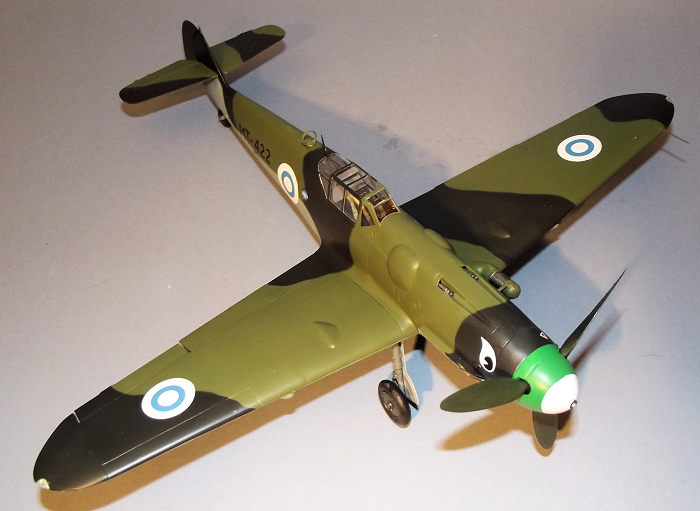 he roundels for the national insignia were backed up
with some White discs from a generic sheet as an insurance against the darker
camouflage paint showing through. The rest of the decals went on with much
patience but without drama. There is little in the way of stencilling on the
airframe since there was none on the decal sheet and I do not know of any
generic stencilling in the Finnish language. The airframe had in any event been
repainted from its delivery colours of some years before, so I contented myself
with the thought that the original German stencilling would have been painted
out and just added a few of the fuelling markings.
he roundels for the national insignia were backed up
with some White discs from a generic sheet as an insurance against the darker
camouflage paint showing through. The rest of the decals went on with much
patience but without drama. There is little in the way of stencilling on the
airframe since there was none on the decal sheet and I do not know of any
generic stencilling in the Finnish language. The airframe had in any event been
repainted from its delivery colours of some years before, so I contented myself
with the thought that the original German stencilling would have been painted
out and just added a few of the fuelling markings.
A last coat of Klear sealed the decals and the aircraft began to take shape with the installation of the cowl side intake, landing gear, aileron mass balances and aerials. A Hasegawa air filter from the spares box fixed onto the cowl intake without fuss and some under wing cannon pods, also from the spares box, glued into place. The propeller assembly was added.
The whole airframe was sprayed with Xtracrylix flat varnish. The canopy masking could finally be removed. The final detail was to add the wing tip light covers.
| CONCLUSIONS |
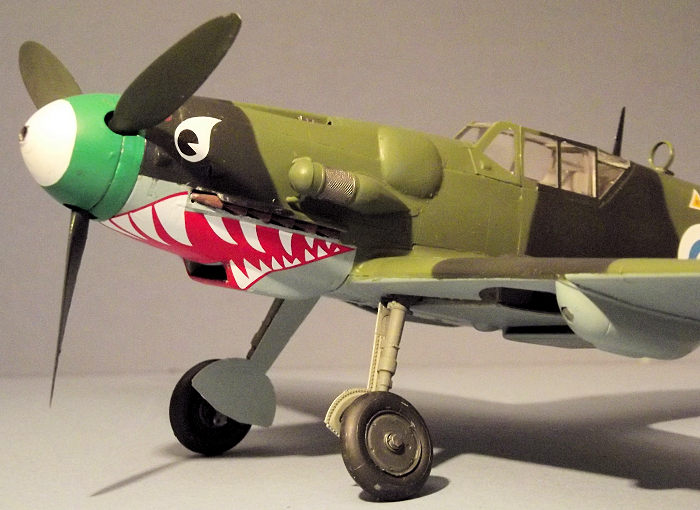 A Bf109G that is not camouflaged in RLM 74/75/76
colours; no mottling and not a swastika in sight. How refreshing.
I ended up with a representative
model of a post-war Finnish Bf109G, with the shark mouth that it definitely had,
in a camouflage pattern that it is likely to have had.
A Bf109G that is not camouflaged in RLM 74/75/76
colours; no mottling and not a swastika in sight. How refreshing.
I ended up with a representative
model of a post-war Finnish Bf109G, with the shark mouth that it definitely had,
in a camouflage pattern that it is likely to have had.
The use of 35 year old decals was a calculated risk since there was no easy prospect of obtaining replacement if something went wrong. It reached the finish line. That’s modelling for you.
| REFERENCES |
Suomen Ilmavoimein Historia No 23 “Sotamaalaus – Warpaint” by Kelevi Keskinen and Kari Stenman. 2003. Kari Stenman Publications.
Suomen Ilmavoimein Historia No 6 “Messerschmitt Bf109G-6” by Kelevi Keskinen and Kari Stenman. 2004. Publisher Hobby-Kustannus oy.
29 March 2019
Copyright ModelingMadness.com
Project courtesy of my wallet
If you would like your product reviewed fairly and fairly quickly, please contact the editor or see other details in the Note to Contributors.
Back to the Main Page Back to the Review Index Page Back to the Previews Index Page